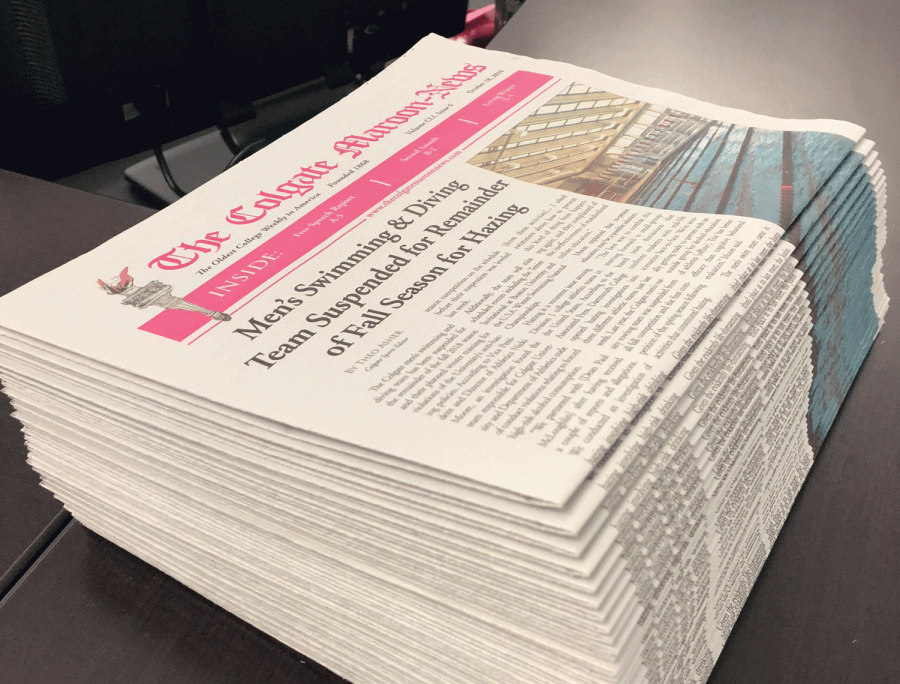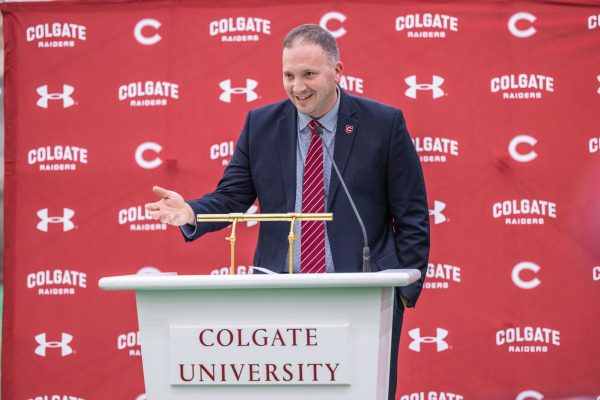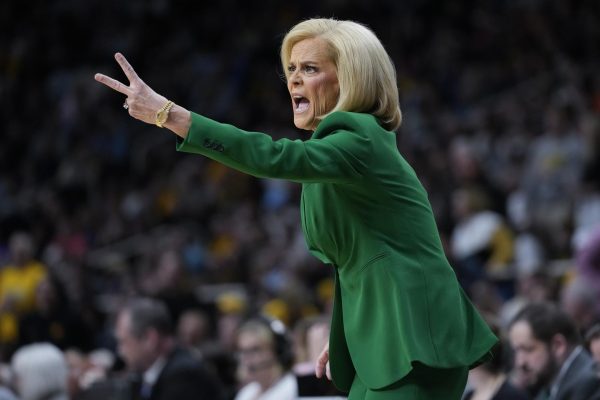Investigation Finds Swimmers Responsible for Maroon-News Theft
Maroon-News copies went missing from most campus drop-off locations on October 19. Fewer than 150 of nearly 1,000 copies have been accounted for.
A Campus Safety investigation found members of Colgate’s swimming and diving teams responsible for the October 19 removal of copies of The Maroon-News’ sixth issue from drop-off locations across campus. The investigation, which closed on November 2, accounted for fewer than 150 of the nearly 1,000 papers that went missing the day after they were distributed.
According to Vice President and Dean of the College Paul McLoughlin, two members of the men’s team and one member of the women’s team admitted to taking newspapers from their drop-off points, citing frustration with the Maroon-News’ October 18 front-page story about the men’s team’s suspension for hazing.
One of the members of the men’s team alleged that he was upset with the article because it contained a photo of the men’s team practicing in their Speedos that was obtained without the team’s consent. The front-page photo contained a photograph of the pool during open swim and had no identifiable people in it.
Administrators cited the Family Educational Rights and Privacy Act, a federal law that protects the privacy of student records, as their reason for not revealing the students’ names.
According to Dan Gough, Associate Vice President of Campus Safety, and McLoughlin, Campus Safety reviewed available video surveillance footage, worked with athletics administrators and interviewed students in order to identify the people who took the papers. Gough also said the theft was not organizational or pre-planned in nature and that each person was identified or came forward individually.
The three swimmers were found in violation of Colgate’s student code of conduct, which claims: “Colgate expects that its students will not lie, steal, cheat, or engage in dishonest or unlawful behavior; behavior that damages University property, the personal property of another individual, or public property; or any other behavior intended to inflict physical or emotional harm on oneself, another person or the community.”
When asked by those handling the investigation what the Maroon-News would like to see in terms of disciplinary processes, the Maroon-News requested that the thieves be held responsible for reimbursing the printing costs of the paper, assisting in the redistribution of the missing issue if it was to be reprinted, issuing an apology and making a donation to the Breast Cancer Research Foundation, as the sixth issue of the newspaper was pink instead of its usual maroon to encourage donations for Breast Cancer Awareness Month.
McLoughlin said that two of the three students, each of whom claimed that they took fewer than twenty papers, were given warnings. The third, who was identified by video surveillance and admitted to taking at least 100 papers from Case-Geyer Library, was placed on probation and asked to pay $100 in restitution for the number of copies he removed. One hundred copies of the paper, or two stacks, are valued at $200, leaving the student responsible for reimbursing 50 percent of the cost of the papers he stole. Probation is defined in the Student Handbook as “a written reprimand for violation of the Code of Student Conduct, providing for more severe disciplinary sanctions in the event that the student is found in violation of any university policy, procedure or directive within a specified period of time.”
The three students were also asked to submit anonymous, written apologies to Maroon-News staff, recognizing the time and effort put into producing each issue of the paper. As of this writing, two of the three requested apologies were obtained, seven percent of the total printing and distribution costs for the missing issue will be reimbursed and no further action will be taken against the individuals involved. Overall, the investigation accounted for 15 percent of the papers that were stolen.
“I am confident that Colgate’s Campus Safety Department conducted a thorough investigation of this matter and feel that our office’s response was appropriate,” Kim Taylor, Associate Dean for Conduct and Administrative Advising, said. “In addition to the disciplinary sanctions put in place by our office, we had substantive and meaningful conversations with the involved students, each of whom took responsibility for their behavior.”
Vice President and Director of Athletics Nicki Moore declined to comment on the investigation, which found only individual members of the men’s and women’s swim teams responsible and not the organization as a whole.
According to the Student Press Law Center (SPLC), a non-profit organization that promotes student journalism and freedom of the press, college newspaper theft is a common response to controversial articles. The SPLC has tracked 286 newspaper theft incidents across the United States since 2000 and estimates that 564,205 newspapers have been stolen from college campuses in the past 18 years.
“Newspaper theft is a dangerously effective form of censorship,” Senior Legal Counsel to the SPLC Mike Hiestand said. “I urge Colgate and local law enforcement officials to treat this as the serious crime that it is. There have been a number of successful prosecutions of newspaper thefts.”
Though copies of the Maroon-News are complimentary to Colgate students and Hamilton residents, the cost to print and distribute papers makes up 78 percent of the Maroon-News’ operating budget, which comes from student activity fees. Each edition of the paper costs approximately $1,407 to produce.
Contact Karrie Spychalski and Mara Stein at [email protected] and [email protected].












